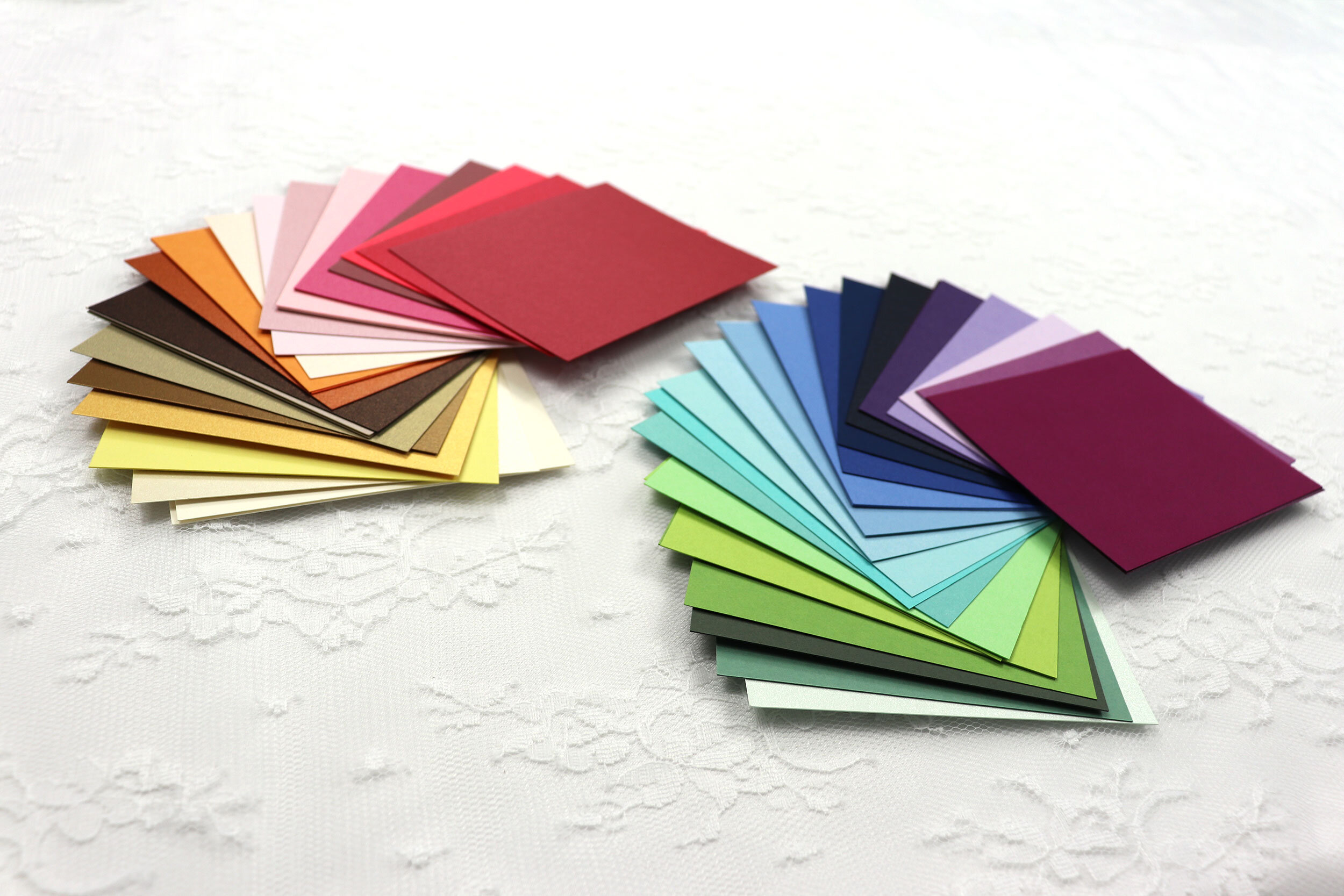5 Papers to Enhance Your Wedding Invitations
When you’re planning a wedding, you become an overnight expert in many things—diamonds, flowers, and event organization to name a few. If you decide to go the custom invitation route—whether you’re working with a professional or DIYing it—then you need to add paper to that list.
But there’s no need to get snow blinded by the different types of paper out there. Below are five types of common cardstocks with recommendations on how and when to use them for your wedding invitations.
Smooth Paper
The Blank Canvas
This is a broad category that incorporates any cardstock with a flat, non-textured surface. If you’ve printed a birthday or Christmas card on your home printer, you’ve likely reached for a white, smooth cardstock.
Smooth paper comes in a variety of thicknesses (or weights) and colors. It may also have a matte or satin finish. Satin is a semi-gloss finish that is less shiny than glossy photo paper but has a greater sheen than matte.
When to use smooth paper:
· Best for detailed designs. If your design has bold flowers or other large, colorful elements, then the modest smooth paper is the way to go.
· Best for the budget.
· Great for mixing and layering different colored stocks.
· Satin finishes are excellent for designs with photography.
· Best for DIY invitations. Many smooth papers are compatible with home printers, although check that your printer can handle cover weight papers. (Sheet feeders work best.) Start with cardstock between 65lbs-80lbs. Often home printers struggle to print on cardstock over 100lbs.
· Best for large patches of color, or flood-coating. Not recommended for home printers, though, particularly inkjets. The large quantity of ink may streak or curl the paper.
Textured Paper
The Lagniappe (Little Extra)
Textured paper is any paper that has an embossed pattern. Resumes and certificates are often printed on this stock. The most common types are linen, laid, and felt.
Textured paper is more limited in colors than smooth. If you’re into DIY invitations, make sure to purchase cover weight, not text weight. Text weight is great for resumes, although it might be too flimsy for your wedding stationery.
When to use textured paper:
· Great for text-based designs that require added elegance.
· Best for traditional looks.
· Works best with thicker fonts.
· Sets off simple monograms.
Metallic Paper
Shimmer & Shine
Also called pearl and shimmer, metallic cardstock has a shiny finish. Much like smooth paper, it comes in a variety of colors.
But unlike smooth paper, metallic is not the best choice for at-home printing, particularly if you have an inkjet printer. The ink from an inkjet takes longer to soak into the paper, so there’s a high risk of smudging. If you choose to print addresses on metallic envelopes, it’s best to ask a professional designer or printer for assistance. Also, even on bright white metallic stocks, bold colors tend to reproduce less vibrantly.
When to use metallic cardstock:
· Excellent for mixing and layering different colored stocks.
· Great for embellishments such as pocket folds, gate cards, mat backings, belly bands, envelope liners, etc.
· Best for adding glam without a significant price increase.
· Works better with laser printers.
Translucent Vellum
The Versatile
The term “vellum” has different definitions and uses in the paper world. But for stationery purposes, translucent vellum is a smooth, see-through paper made from plant fibers. Its popularity has grown in the last years.
Translucent vellum comes in several thicknesses and colors, although white is the most versatile. It is compatible with home printers, although results may vary, so testing is recommended.
When to use translucent vellum:
· Great for adding elegance when the budget counts.
· Consider vellum wraps for dramatic reveals and vellum overlays for depth.
· Vellum inner envelopes add a surprising touch.
· Works well with white ink and full-color digital printing.
· Looks great combined with wax seals.
Cotton Paper
Creme de la Creme
Cotton paper is a soft, high-quality paper made from cotton fibers. Cotton is the crème de la crème of paper, often used for fine art paper and official documents. You’ll never go wrong with cotton, and I print a lot of my staged samples on bright white cotton paper.
Of course, the quality does come with a higher price tag. You can expect to pay at least 20 cents more per print if you choose cotton paper. But the quality is worth it—artwork will reproduce brighter and sharper on cotton than on smooth paper. Plus, cotton paper will generally endure longer than papers made from wood pulp.
When to use cotton paper:
· Best for longevity.
· Best for letterpress invitations.
· Great for adding sophistication and luxury to your invitations.
· Versatile and appropriate for most designs.
· Better for mid to high range budgets.
Whether you’re a DIYer or working with a professional, choosing the right paper for your invitations can be a fun experience. At Camellia Memories, I’m proud to offer all of these papers for your wedding stationery. For local couples, I provide one-on-one consultations where you may touch and handle samples yourself. Paper can make or break an invitation, and I’m here to help you make the right choice!






